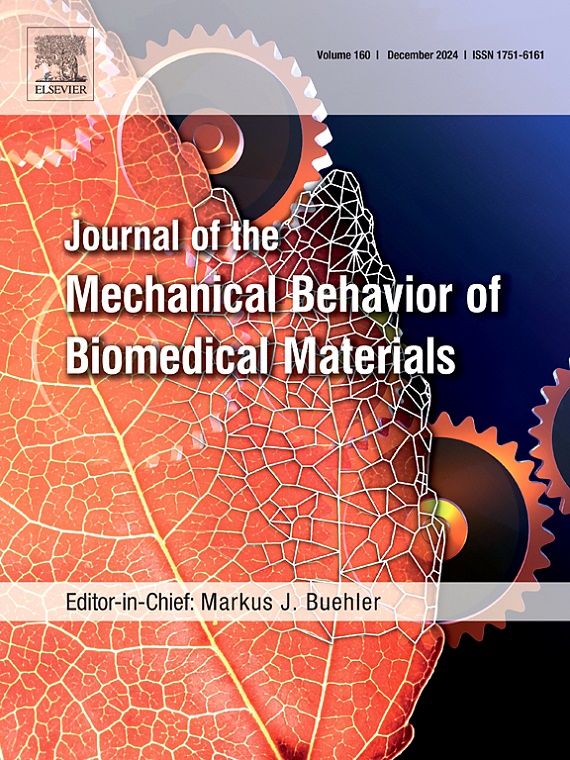The role of the membrane in the hen's egg as a model for increasing the toughness of engineered brittle materials
IF 3.5
2区 医学
Q2 ENGINEERING, BIOMEDICAL
Journal of the Mechanical Behavior of Biomedical Materials
Pub Date : 2025-06-17
DOI:10.1016/j.jmbbm.2025.107101
引用次数: 0
Abstract
Eggshell and the attached membrane are the focus of many fields of research, but their mechanical properties as a biomineralised composite are seldom explored. This investigation aimed to asses the influence of the membrane on energy dissipation during macroscopic structure failure, and if this effect could be reproduced with artificial membranes for later use in biomimetic materials. Compression tests followed by fracture pattern analysis were conducted for five types of manipulated egg halves: samples with and without the natural membrane, and three samples where the membrane was replaced with artificial membranes made from epoxy resin, polyurethane resin, or wood glue. To preserve the shell's shape, the natural membrane was removed with NaClO. Significant differences regarding the fracture forces between samples with the natural membrane and no membrane (20 % decrease of average), and the natural and artificial membranes (30 % increase of average) were measured. Fracture pattern analysis and investigation of the total work performed during compression testing revealed the highest improvements in toughness for the artificial polyurethane-resin membrane. Without any membrane, very small amounts of work were required to completely shatter the egg, and no fragment cohesion was observed. The presence of the membrane significantly enhanced the effective toughness of the eggshell, and the biomimetic abstraction of this concept is considered feasible for further investigation involving engineered brittle materials.

薄膜在鸡蛋中的作用,作为增加工程脆性材料韧性的模型
蛋壳及其附着膜是许多领域的研究热点,但其作为生物矿化复合材料的力学性能研究却很少。本研究旨在评估在宏观结构破坏过程中膜对能量耗散的影响,以及这种效应是否可以用人工膜复制,以供以后用于仿生材料。对五种处理过的半鸡蛋进行了压缩测试,然后进行了断裂模式分析:有和没有天然膜的样品,以及用环氧树脂、聚氨酯树脂或木胶制成的人造膜代替膜的三种样品。为了保持外壳的形状,天然膜被NaClO去除。有天然膜和无膜样品的断裂力差异显著(平均减小20%),有天然膜和人工膜样品的断裂力差异显著(平均增大30%)。在压缩测试中进行的断裂模式分析和总工作量调查表明,人造聚氨酯树脂膜的韧性得到了最大的改善。在没有任何膜的情况下,完全粉碎卵子只需要很少的功,并且没有观察到碎片的凝聚力。膜的存在显著提高了蛋壳的有效韧性,这一概念的仿生抽象被认为是可行的,可以进一步研究工程脆性材料。
本文章由计算机程序翻译,如有差异,请以英文原文为准。
求助全文
约1分钟内获得全文
求助全文
来源期刊

Journal of the Mechanical Behavior of Biomedical Materials
工程技术-材料科学:生物材料
CiteScore
7.20
自引率
7.70%
发文量
505
审稿时长
46 days
期刊介绍:
The Journal of the Mechanical Behavior of Biomedical Materials is concerned with the mechanical deformation, damage and failure under applied forces, of biological material (at the tissue, cellular and molecular levels) and of biomaterials, i.e. those materials which are designed to mimic or replace biological materials.
The primary focus of the journal is the synthesis of materials science, biology, and medical and dental science. Reports of fundamental scientific investigations are welcome, as are articles concerned with the practical application of materials in medical devices. Both experimental and theoretical work is of interest; theoretical papers will normally include comparison of predictions with experimental data, though we recognize that this may not always be appropriate. The journal also publishes technical notes concerned with emerging experimental or theoretical techniques, letters to the editor and, by invitation, review articles and papers describing existing techniques for the benefit of an interdisciplinary readership.
 求助内容:
求助内容: 应助结果提醒方式:
应助结果提醒方式:


